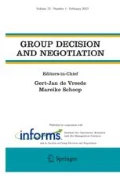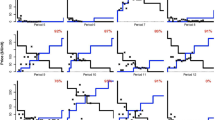Abstract
Conditional decision markets concurrently predict the future and decide on it. These markets price the impact of decisions, conditional on them being executed. After the markets close, a principal decides which decisions are executed based on the prices in the markets. As some decisions are not executed, the respective outcome cannot be observed, and the markets predicting the impact of non-executed decisions are void. This allows ex-post costless manipulation of such markets. We conduct two versions of an online experiment to explore scenarios in which a principal runs conditional decision markets to inform her choice among a set of a risky alternatives. We find that the level of manipulation depends on the simplicity of the market setting. When a trader is alone, has the power to move prices far enough, and the decision is deterministically tied to market prices or a very high correlation between prices and decision is implied, only then manipulation occurs. As soon as another trader is present to add risk to manipulation, manipulation is eliminated. Our results contrast theoretical work on conditional decision markets in two ways: First, our results suggest that manipulation may not be as meaningful an issue. Second, probabilistic decision rules are used to add risk to manipulation; when manipulation is not a meaningful issue, deterministic decisions provide the better decision with less noise. To the best of our knowledge, this is the first experimental analysis isolating the effects of the conditional nature of decision markets.

Similar content being viewed by others
Notes
A good example of this is the American Civics Exchange which trades on political outcomes for real cash prizes. They are not conditional decision markets, but since they freeze their market once per month and provide prizes based on the performance of the participants with the current prices, they are subject to a very similar form of manipulation. In their first month they found out that traders were manipulating prices just under the deadline, which would only work if no other trader had time to counter and take the free money (in expectation). Thus, they switched to a random, unannounced, closing time on the announced final day: http://www.amciv.com/rules/.
References
Amir O, Rand DG, Gal YK (2012) Economic games on the internet: the effect of $1 stakes. PLoS ONE 7(2):e31461
Bennouri M, Gimpel H, Robert J (2011) Measuring the impact of information aggregation mechanisms: an experimental investigation. J Econ Behav Organ 78(3):302–318
Berg JE, Nelson FD, Rietz TA (2008) Prediction market accuracy in the long run. Int J Forecast 24(2):285–300
Berg JE, Rietz TA (2003) Prediction markets as decision support systems. Inf Syst Front 5(1):79–93
Bughin J, Chui M, Pollak L (2013) Organizing for change through social technologies: McKinsey global survey results. McKinsey & Company Inc, New York
Chen Y, Dimitrov S, Sami R, Reeves D, Pennock D, Hanson RD, Fortnow L, Gonen R (2010) Gaming prediction markets: equilibrium strategies with a market maker. Algorithmica 58(4):930–969
Chen Y, Kash I, Ruberry M, Shnayder V (2011) Decision markets with good incentives. In: Internet and network economics, Springer, pp 72–83
Chen Y, Kash IA (2011) Information elicitation for decision making. In: Proceedings of the 10th international conference on autonomous agents and multiagent systems (AAMAS’11)
Chinn S (2000) A simple method for converting an odds ratio to effect size for use in meta-analysis. Stat Med 19:3127–3131
Deck C, Lin S, Porter D (2013) Affecting policy by manipulating prediction markets: experimental evidence. J Econ Behav Organ 85:48–62
Dimitrov S, Sami R (2008) Non-Myopic strategies in prediction markets. In: Proceedings of the 9th ACM conference on electronic commerce (EC’08), pp 200–209
Dimitrov S, Sami R (2010) Composition of markets with conflicting incentives. In: Proceedings of the 11th ACM conference on electronic commerce (EC’11), pp 53–62
Gibbard A (1977) Manipulation of schemes that mix voting with chance. Econometrica 45(3):665–681
Gimpel H, Teschner F (2013a) Collective intelligence in market-based social decision making. In: Proceedings of the thirty fourth international conference on information systems (ICIS’13)
Gimpel H, Teschner F (2013b) Prediction markets with experts concerned in post-market information usage: experimental evidence on collective intelligence. Available at SSRN 2292116
Gneiting T, Raftery AE (2007) Strictly proper scoring rules, prediction, and estimation. J Am Stat Assoc 102(477):359–378
Hanson RD (1999) Decision markets. IEEE Intell Syst 14(3):16–99
Hanson RD (2003) Combinatorial information market design. Inf Syst Front 5(1):107–119
Hanson RD (2007) Logarithmic market scoring rules for modular combinatorial information aggregation. J Predict Mark 1(1):1–15
Hanson R, Oprea R, Porter D (2006) Information aggregation and manipulation in an experimental market. J Econ Behav Organ 60(4):449–459
Healy PJ, Linardi S, Lowery JR, Ledyard JO (2010) Prediction markets: alternative mechanisms for complex environments with few traders. Manag Sci 56(11):1977–1996
Horton JJ, Rand DG, Zeckhauser RJ (2011) The online laboratory: conducting experiments in a real labor market. Exp Econ 14(3):399–425
Jian L, Sami R (2012) Aggregation and manipulation in prediction markets: effects of trading mechanism and information distribution. Manag Sci 58(1):123–140
Ledyard J, Hanson R, Ishikada T (2009) An experimental test of combinatorial information markets. J Econ Behav Organ 69(2):182–189
Mason W, Suri S (2012) Conducting behavioral research on Amazon’s mechanical turk. Behav Res Methods 44(1):1–23
McCarthy J (1956) Measures of the value of information. PNAS Proc Natl Acad Sci U. S. A 42(9):654–655
Oprea R, Porter D, Hibbert C, Hanson R, Tila D (2007) Can manipulators mislead market observers? University of California, Santa Cruz, mimeo
Othman A, Sandholm T (2010) Decision rules and decision markets. In: Proceedings of the 9th international conference on autonomous agents and multiagent systems (AAMAS’10), pp 625–632
Pennock DM, Sami R (2007) Computational aspects of prediction markets. In: Algorithmic game theory, Cambridge University Press, Ch. 26, pp 651–674
Rhode PW, Strumpf KS (2006) Manipulating political stock markets: a field experiment and a century of observational data. University of Arizona, Mimeo
Rothschild DM, Sethi R (2013) Trading strategies and market microstructure: evidence from a prediction market. Available at SSRN 2322420
Savage LJ (1971) Elicitation of personal probabilities and expectations. J Am Stat Assoc 66(336):783–801
Teschner F, Coblenz M, Weinhardt C (2011) Short-selling in prediction markets. J Predict Mark 5(2):14–31
Wagman L, Conitzer V (2008) Optimal false-name-proof voting rules with costly voting. In: Proceedings of the national conference on artificial intelligence (AAAI’08), pp 190–195
Wolfers J, Zitzewitz E (2006) Interpreting prediction market prices as probabilities (No. w12200). National Bureau of Economic Research
Author information
Authors and Affiliations
Corresponding author
Electronic supplementary material
Below is the link to the electronic supplementary material.
Rights and permissions
About this article
Cite this article
Teschner, F., Rothschild, D. & Gimpel, H. Manipulation in Conditional Decision Markets. Group Decis Negot 26, 953–971 (2017). https://doi.org/10.1007/s10726-017-9531-0
Published:
Issue Date:
DOI: https://doi.org/10.1007/s10726-017-9531-0




